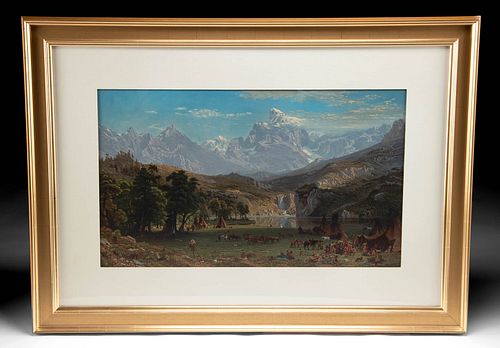Bierstadt - "The Rocky Mountains Landers Peak" (1869)
About Seller
686 S Taylor Ave, Ste 106
Louisville, CO 80027
United States
Selling antiquities, ancient and ethnographic art online since 1993, Artemis Gallery specializes in Classical Antiquities (Egyptian, Greek, Roman, Near Eastern), Asian, Pre-Columbian, African / Tribal / Oceanographic art. Our extensive inventory includes pottery, stone, metal, wood, glass and textil...Read more
Two ways to bid:
- Leave a max absentee bid and the platform will bid on your behalf up to your maximum bid during the live auction.
- Bid live during the auction and your bids will be submitted real-time to the auctioneer.
Bid Increments
| Price | Bid Increment |
|---|---|
| $0 | $25 |
| $300 | $50 |
| $1,000 | $100 |
| $2,000 | $250 |
| $5,000 | $500 |
| $10,000 | $1,000 |
| $20,000 | $2,500 |
| $50,000 | $5,000 |
| $100,000 | $10,000 |
| $200,000 | $20,000 |
About Auction
Nov 10, 2022
Museum-worthy examples of classical antiquities (Egyptian, Greek, Roman, Near Eastern), Viking, Far East / Asian, Pre-Columbian, African / Tribal, Oceanic, Native American, Spanish Colonial, Nautical, Fossils, Ancient Jewelry, Fine / Visual Arts, so much more! Artemis Fine Arts info@artemisfinearts.com
- Lot Description
**This is an oversized piece that may require special shipping. Please inquire for a quote prior to bidding.
Albert Bierstadt (German-American, 1830-1902). "The Rocky Mountains Landers Peak" chromolithograph by H.M. Long, published by Thomas McLean, London, UK, 1869. Signed and dated in the plate. A grand chromolithograph of Albert Bierstadt's famous "The Rocky Mountains, Lander's Peak" - the landscape that established Bierstadt as the most beloved painter of the American West during the 19th century. In 1863, nearly 1,000 people attended the exhibition of this painting, and in 1865 it sold for an impressive $25 000. The composition features a Native American campsite, including figures in traditional dress, tepees, and horses occupying the verdant meadow in the foreground as well as the majestic snow-peaked Rocky Mountains beyond, all delineated in Bierstadt's remarkably realistic style. A very special piece set in a custom, museum-quality frame behind glass. Size (sight view): 19" L x 32" W (48.3 cm x 81.3 cm) Size (frame): 33.75" L x 46.75" W (85.7 cm x 118.7 cm)
Albert Bierstadt (1830-1902) was born in Germany, near Dusseldorf; however, he grew up in the United States. In his twenties he returned to Germany to study at the reputable Dusseldorf Academy. In addition to this school's tradition of heroic painting, the Hudson River School tradition would greatly impact the young Bierstadt who would go on to be best known for his grand paintings of the American West. Depicting the breathtaking beauty of such awe-inspiring locales as the Rocky Mountains and Yosemite Valley, Bierstadt's art also reflected the notion of Manifest Destiny in support of westward expansion.
Despite spending his formative years in Europe, Albert Bierstadt was best known for his mesmerizing landscape paintings of the American West. Bierstadt's painting "The Rocky Mountains, Lander's Peak" (1863) was collected by the Metropolitan Museum of Art (accession number 07.123). The Met's curatorial department provides the following description, "This and other popular canvases by the German-born Albert Bierstadt shaped the visual identity of the American West in the United States and abroad. In early 1859 he accompanied a government survey expedition, headed by Frederick W. Lander, to the Nebraska Territory. By summer, the party had reached the Wind River Range of the Rocky Mountains in present-day Wyoming. Painted in New York after Bierstadt’s return from these travels, this work advertised the landscape as a frontier destined to be claimed by White settlers, according to the doctrine of Manifest Destiny. This belief that Americans were the divinely ordained "masters" of the continent systematically ignored with dire consequences the presence of Indigenous populations, such as the Shoshone peoples depicted in the picture’s foreground. Publicly exhibited to great acclaim, this monumental painting established Bierstadt as a key competitor of the preeminent landscape painter, Frederic Edwin Church (see, for example, 09.95). It was purchased in 1865 for the then-astounding sum of $25,000 by James McHenry, an American living in London. Bierstadt later bought it back and gave or sold it to his brother Edward."
Provenance: private Albuquerque, New Mexico, USA collection; ex-Hugh K. Tirrell estate, representative Priscilla T. Bisher
All items legal to buy/sell under U.S. Statute covering cultural patrimony Code 2600, CHAPTER 14, and are guaranteed to be as described or your money back.
A Certificate of Authenticity will accompany all winning bids.
We ship worldwide and handle all shipping in-house for your convenience.
#175645Signed and dated in the plate. Mounted in a custom, museum-quality frame with a linen matte behind glass. Chromolithograph has not been examined outside the frame but appears to be in overall excellent condition. Framing is excellent. Professional suspension hardware (Wallbuddies) on verso and ready to display.Condition
- Shipping Info
-
Artemis Gallery will no longer be able to offer in-house shipping for most international orders, as well as all oversized orders, including most paintings. These items are clearly marked in the listing as “3rd Party Shipping Required” in the listing. We have a list of recommended third party shippers to assist you in shipping to and from, and would be happy to assist you in working with them. We require a written authorization from the client to release property to any third party. You may fax a Shipping Release Form to 303-828-3235 or email your authorization to kristen@artemisgallery.com. Please note the all property must be removed from our premises within seven (7) business days following the last day of the auction.
-
- Buyer's Premium



 EUR
EUR CAD
CAD AUD
AUD GBP
GBP MXN
MXN HKD
HKD CNY
CNY MYR
MYR SEK
SEK SGD
SGD CHF
CHF THB
THB














